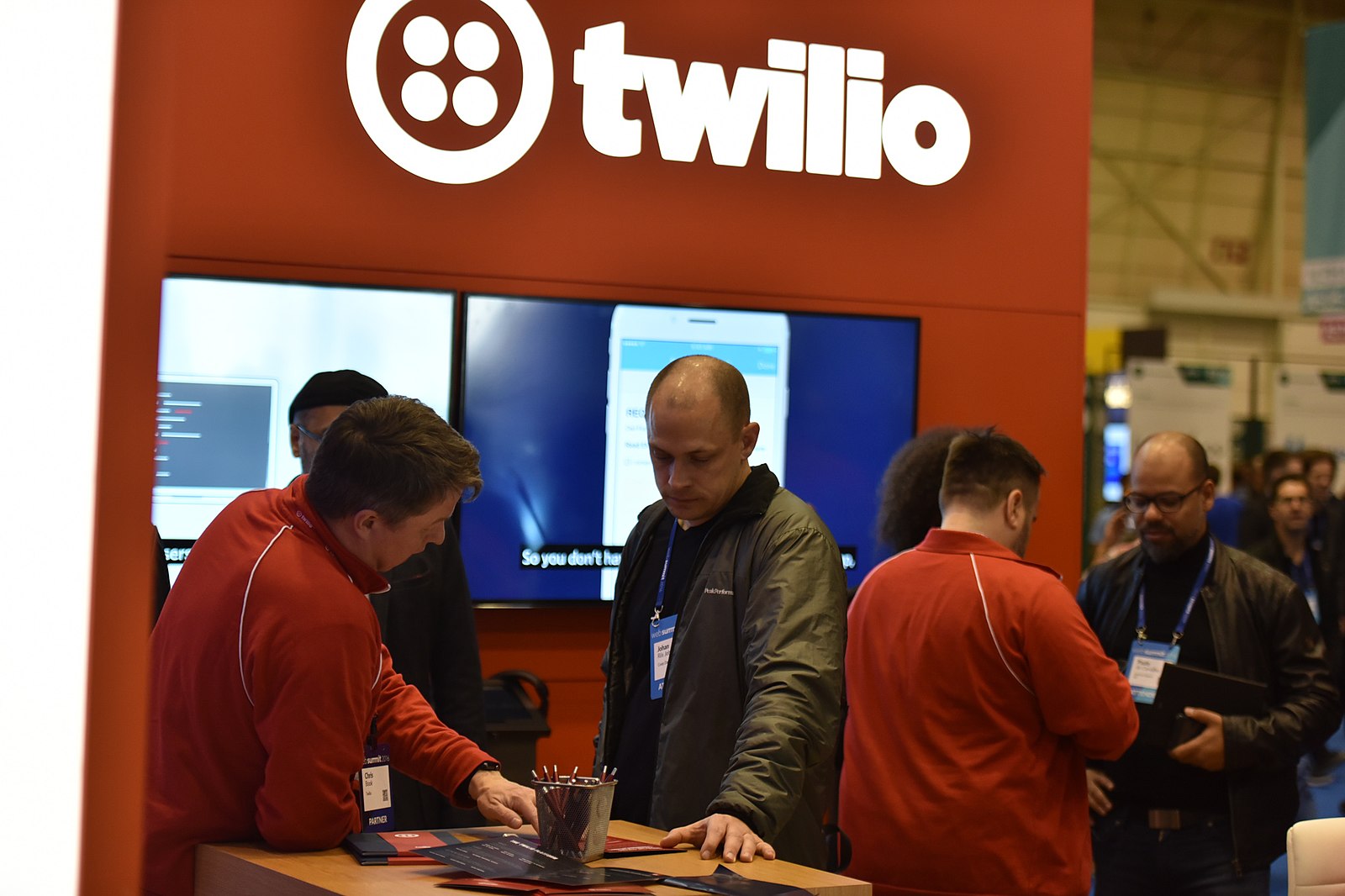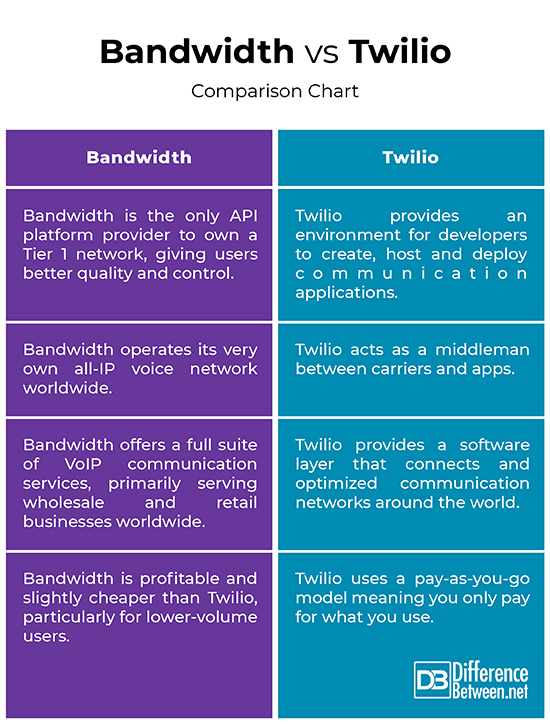Difference Between Bandwidth and Twilio
Platform-as-a-Service (PaaS) serves as a delivery mechanism for communications platforms, which allows developers to add communication features such as voice, messaging, and video to applications. PaaS gives end users the platform and the environment to develop, manage and run applications over the Internet. Companies use PaaS to develop, manage, run and secure application programming interfaces (APIs) and microservices. That being said, Bandwidth and Twilio are the world’s leading cloud communications providers for app developers that are transforming the way people communicate. We bring you a head-to-head comparison between the two CPaaS providers in terms of pricing, products and services.

What is a Bandwidth Inc.?
Bandwidth Inc. is a cloud-based communications platform as a service (CPaaS) company, based out of Raleigh, North Carolina. It is a world’s leading provider of telecommunication services that’s transforming the way people communicate. Formerly Bandwidth.com, Inc., Bandwidth offers a full suite of VoIP communication services, primarily serving wholesale and retail businesses worldwide. Customers turn to Bandwidth looking for ways to navigate everything from choosing a provider to finding the best communication technologies on the market. The company was founded by David Morken in 1991 and in 2001, Henry Kaestner joined him as the co-founder, finally merging Bandwidth International into Bandwidth.com. In 2013, Bandwidth moved to Raleigh, North Carolina in the Centennial Campus of the North Carolina State University. Bandwidth is associated with some of the biggest names in the industry including Google, GoDaddy, Skype, arlo, Rover, and more.

What is a Twilio?
Twilio is a leading cloud computing communications Platform as a Service (PaaS) company, based out of San Francisco, California. Twilio is an open PaaS platform which focuses on communication services and provides APIs to programmatically send, receive and track text messages worldwide, while also allowing you to test your SMS-enabled applications within a sandbox environment. Twilio allows its clients to integrate voice, messaging and VoIP capabilities into web, desktop or mobile applications. It packs the complex underlying communication function into APIs which allow software developers and companies to create, host and deploy communication applications. Twilio added speech recognition to its platform which allows it to translate a user’s voice into text. Twilio provides a software layer that connects and optimized communication networks around the world and this is how developers can allow users to call and text anyone anywhere with little or no cost.
Difference between Bandwidth and Twilio
Profile
– Both Bandwidth and Twilio are the leading cloud-based Platform-as-a-Service (PaaS) companies providing software APIs for voice and messaging. Bandwidth offers a full suite of VoIP communication services, primarily serving wholesale and retail businesses worldwide. Bandwidth is associated with some of the biggest names in the industry including Google and it is the only API platform provider to own a Tier 1 network. Twilio, on the other hand, packs the complex underlying communication function into APIs which allow software developers and companies to create, host and deploy communication applications. Twilio is a go-to for cloud-based communication APIs.
Products and Services
– Bandwidth offers a full suite of VoIP communication services, primarily serving wholesale and retail businesses worldwide. Bandwidth offers a full suite of cloud-ready voice, messaging and 9-1-1 APIs, all built on top of the company’s very own all-IP voice network. Twilio focuses on communication services and provides APIs to programmatically send, receive and track text messages worldwide, while also allowing you to test your SMS-enabled applications within a sandbox environment. Twilio offers a plethora of services that clearly outweighs that of Bandwidth’s. While both provide a full suite of communication services for voice and messaging, Twilio makes it even easier with a few lines of code.
Pricing
– When it comes to pricing, Bandwidth is profitable and slightly cheaper than Twilio, particularly for lower-volume users. Twilio uses a pay-as-you-go model meaning you only pay for what you use, with prices starting at $0.0130/min for making calls and $0.0085/min for receiving calls, and $0.0075 for sending and receiving messages. Twilio costs $14.95 per month for up to 100k emails (up to 40k free emails for a month), $0.0042 for a WhatsApp Template message and $0.005 for WhatsApp Session messages.
However, unlike Twilio, which acts as a middleman between carriers and apps, Bandwidth has its very own all-IP voice network, which makes sure you don’t pay a dime to any third-party provider. Bandwidth provides a very flexible and wholesale pricing structure to cater to customers of all sizes. Voice calling starts at $0.0055/min for incoming and $0.01/min for outgoing calls; incoming messages are free, while you have to pay $0.005 to send a message. So, Bandwidth is the clear winner when it comes to pricing.
Bandwidth vs. Twilio: Comparison Chart

Summary of Bandwidth vs. Twilio
While both Bandwidth and Twilio are the leading Communications Platform as a Service (PaaS) providers that offer a full suite of VoIP communication services to customers worldwide, Twilio makes it easier for the developers to make it work with a fewer lines of code. Twilio addresses nearly every channel for communication including voice, SMS, video calling, chat, etc. However, unlike Twilio, which acts as a middleman, Bandwidth products and services are backed by their own all-IP nationwide voice network. In addition, Bandwidth, thanks to its flexible pricing structure, is profitable and slightly cheaper than Twilio, particularly for lower-volume users, making it a worthy alternative of Twilio.
- Difference Between Caucus and Primary - June 18, 2024
- Difference Between PPO and POS - May 30, 2024
- Difference Between RFID and NFC - May 28, 2024
Search DifferenceBetween.net :
Leave a Response
References :
[0]Rozga, Szymon. Practical Bot Development: Designing and Building Bots with Node.js and Microsoft Bot Framework. New York, United States: Apress, 2018. Print
[1]Ren, Jinchang, et al. Advances in Brain Inspired Cognitive Systems: 10th International Conference, BICS 2019, Guangzhou, China, July 13–14, 2019, Proceedings. Berlin, Germany: Springer, 2020. Print
[2]Stigler, Maddie. Beginning Serverless Computing: Developing with Amazon Web Services, Microsoft Azure, and Google Cloud. New York, United States: Apress, 2017. Print
[3]Image credit: https://upload.wikimedia.org/wikipedia/commons/thumb/f/f6/Bandwidth.svg/500px-Bandwidth.svg.png
[4]Image credit: https://commons.wikimedia.org/wiki/File:Web_Summit_2016_-_Exhibition_Floor_-_Nov_8_-_Day_1_ws_(45_of_79)_(30224603793).jpg
